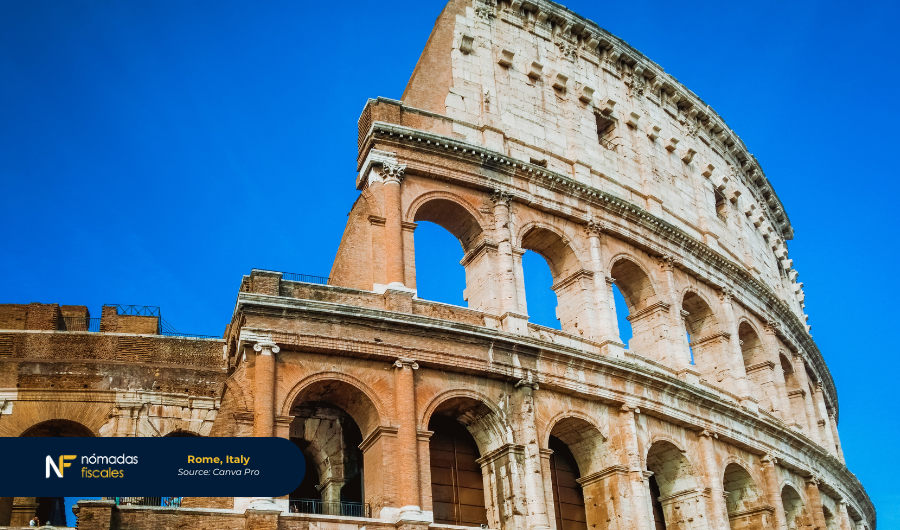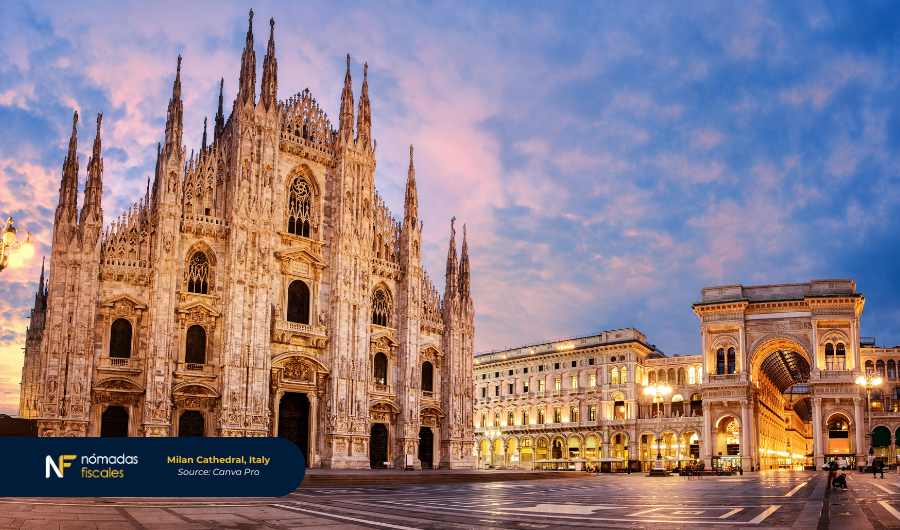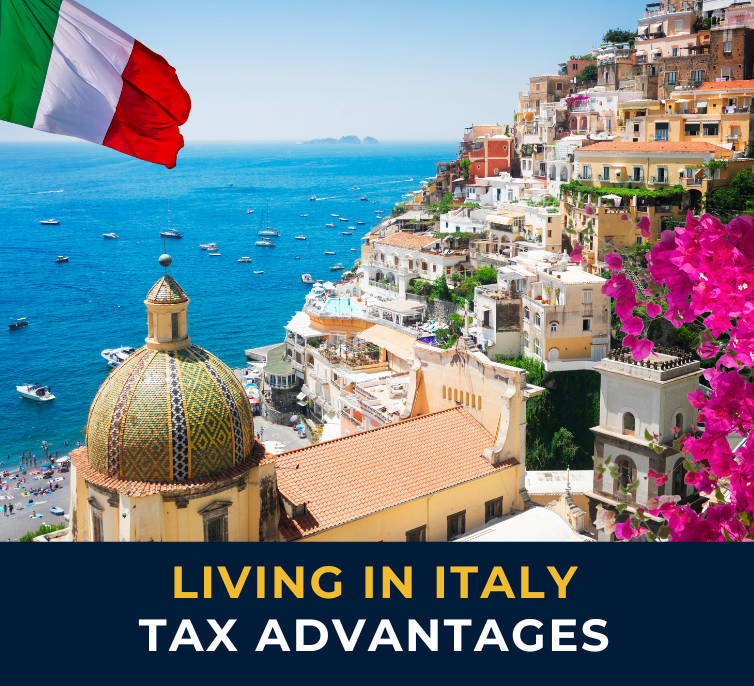Italy is globally recognized for its rich history, vibrant culture, and unmistakable lifestyle.
From the iconic streets of Rome to the majestic hills of Tuscany, passing through the fashion of Milan and the cuisine of Naples, Italy is a country that has left an indelible mark on global culture. It is a dream tourist destination, where every corner seems to come from a postcard, and where the “dolce vita” lifestyle attracts millions of visitors each year.
However, when it comes to tax planning, Italy is not the first country that comes to mind. In fact, it’s quite the opposite: Italy is known for its high taxes, which can often deter those considering settling in the country.
Many assume that enjoying the Mediterranean climate, exquisite cuisine, and the friendly character of Italians comes with a hefty tax bill.
But what few people know is that Italy offers some very interesting tax opportunities for those seeking residence to save on taxes.
Three special tax regimes can make moving to Italy a very attractive option for tax nomads.
In this article, we will explore these regimes, detailing how they work and how you could benefit from them.
Taxes in Italy
As we explained, the Italian tax system resembles a true tax hell.
For example, in personal income tax, the rates range from 23% to 43%, depending on income level.
Additionally, this income tax is complemented by other taxes that can bring us close to a 50% tax burden. These include regional and municipal taxes, which vary depending on the region where you reside in Italy.
Other taxes, such as VAT, are also on the higher end of the scale, with a general rate of 22%. On the other hand, social security contributions hover around 26% on a maximum of €119,000.
There’s also no tax relief when it comes to passive income. If we receive dividends or capital gains, we generally have to pay a 26% tax on these earnings, which is not very appealing either.
These are the taxes that apply to a standard resident in Italy. However, as we will see, there are special tax regimes that can significantly reduce the tax burden, allowing you to enjoy life in Italy with much lower taxes.
We recommend carefully reviewing the characteristics of each regime, as it is not possible to apply for multiple regimes simultaneously. Therefore, you should choose the one that best fits your situation.

Italy’s Non-Dom Regime: The Scheme for Millionaires
The Italian Non-Dom Regime was introduced in 2017 and is quite similar to Switzerland’s Lump Sum Regime, also known as the flat-rate tax scheme, where the tax advantage lies in paying a fixed annual tax.
Originally, in Italy, this tax was €100,000 per year plus €25,000 for each family member. While this amount might seem high, for someone earning millions of euros annually, the effective tax rate can be negligible compared to what they would pay in other countries.
This regime was initially very attractive, as the €100,000 placed Italy below the €150,000 minimum required by Switzerland’s more affordable cantons. However, in 2024, Italy decided to double the fixed sum to €200,000 per year.
Nevertheless, this amount remains attractive to many billionaires wishing to live in Italy, as paying this fixed annual tax allows them to enjoy significant tax benefits for 15 years. During this time, all income generated outside Italy will be completely exempt from taxes, and only income generated within Italy will be subject to taxation.
The only exception occurs if a capital gain is realized from the sale of shares or stakes during the first 5 years of residence in Italy under this regime. However, it is also possible to obtain a tax exemption on these gains if one plans to maintain tax residency in Italy for at least 5 additional years after the sale.
One of the major advantages of the Italian non-dom regime is that foreign income can be brought into Italy without any remittance restrictions, unlike what happens with Malta’s non-dom regime. Additionally, beneficiaries of this regime are fully exempt from paying taxes on wealth, inheritance, and gifts in Italy.
On the other hand, Controlled Foreign Corporation (CFC) rules still apply, so it is crucial to review the structure of foreign companies to avoid any surprises.
This regime is available to individuals who have not been tax residents in Italy for at least 9 of the last 10 years before applying, with no nationality restrictions.
To benefit from this regime, one must meet the requirement of being a tax resident by physically being in Italy for at least 183 days per year and maintaining tax residency for at least two years. If you change your tax residency before completing this period, the authorities will require payment of the taxes you would have owed without the regime’s benefits, along with interest and penalties.
Finally, it is possible to apply for the non-dom regime in the income tax return for the year following the year you became a tax resident. However, there is a risk that you might not know if the regime’s rules will apply until the Italian Tax Agency approves your application. For this reason, it is recommended to seek a tax ruling, which is a pre-approval from the Italian Tax Agency ensuring acceptance under the non-dom regime.
Italy’s Impatriates Regime: 50% Tax Exemption!
The Italian Impatriates Regime, introduced in 2019, has undergone several changes.
Previously, the exemption varied by region, allowing up to 90% tax exemption in southern regions like Campania, Sardinia, and Sicily, while in northern regions the exemption was only 30%. However, starting in 2024, the authorities have decided to standardize this exemption at 50%, regardless of the region.
Requirements:
- Previous Residency: Must not have been a tax resident in Italy for the three years prior.
- Qualification: Must hold a university degree or a highly specialized qualification.
- Minimum Stay: Must commit to residing in Italy for at least four fiscal years. If this commitment is not met, taxes avoided will need to be paid along with interest and penalties.
- Tax Residency: Must spend a minimum of 183 days per year in Italy.
Features:
- Exempt Income: The exemption applies to income derived from employment or self-employment activities, up to a maximum of €600,000 annually.
- Exemption Percentage: Generally, a 50% exemption applies, but it increases to 60% if you have a dependent child under 18.
- Duration: The regime can be enjoyed for a maximum of five fiscal years, including the year of arrival and four additional years.
Despite being a generous exemption, high social security contributions still need to be paid. However, these are capped at around €31,500 annually, which becomes advantageous as income increases, reducing the effective tax burden.
For example, a self-employed individual earning €400,000 annually would pay approximately €31,500 in social contributions. Thanks to the 50% income tax exemption, their IRPEF tax burden would be close to €80,000. This results in an approximate total tax burden of 27%.
While this regime doesn’t reduce taxes to the minimum, it offers a significantly lower tax burden compared to the classic European tax hells.

Pensioners in Italy: Fixed 7% Tax
The 7% Regime for Pensioners in Italy is, in our opinion, the most beneficial of the current tax regimes in the country, and here’s why.
This regime is designed to attract foreign pensioners to repopulate small towns in southern Italy. The main requirement is that the pensioner relocates to a municipality with fewer than 20,000 inhabitants in one of the following regions: Abruzzo, Apulia, Campania, Calabria, Sardinia, Molise, Basilicata, or Sicily.
It is essential to move directly to one of the qualifying municipalities.
Another requirement, as its name implies, is that the individual must be a pensioner. The regime applies to both those receiving a public pension and those with lifetime payments from private pension schemes or life insurance. There is no minimum amount specified; it is only necessary to have a recurring and lifetime source of income.
The most notable tax advantage of this regime is that it offers a fixed rate of 7%, not only on the pension but also on any income derived from abroad. This is especially beneficial for pensioners with other assets, such as stocks or investments generating significant capital gains, as they can tax those gains under this regime without facing a high tax burden.
Additionally, the pensioner can choose whether to tax some income under the 7% regime or according to a double taxation agreement. This option is useful, for example, when the pension must be taxed in the country of origin by the terms of the agreement, allowing avoidance of double taxation.
Under this regime, we are also exempt from wealth tax and the obligation to file informative declarations regarding wealth.
It will be necessary not to have been a tax resident in Italy for the past five years and for the pensioner’s country of citizenship to have a double taxation agreement in force with Italy.
Finally, this regime can be used for up to a maximum of 10 years, without the requirement of a minimum stay period. This means that pensioners can leave Italy at any time without any penalty.
Except for those generating more than three million euros annually in income from abroad, this option will be more favorable than the Italian Non-Dom regime.

Italian Passport
The Italian passport is considered one of the most valuable and prestigious in the world, allowing visa-free entry to over 170 countries.
Although it is not the easiest to obtain, it is also not among the most difficult if the necessary requirements are met:
- For those who are not citizens of the European Union, the naturalization process requires 10 years of legal residence in Italy. In addition to this residency period, it will be necessary to demonstrate basic knowledge of the Italian language and culture.
- For citizens of the European Union, the process is more streamlined and can be completed in just 4 years.
Italy is an excellent option for obtaining a second citizenship, as it allows dual nationality, meaning there is no need to renounce your original passport.
The Italian Golden Visa
The Italian Golden Visa, known as La Dolce Visa, is one of the best options for non-European citizens who wish to obtain residency in the country through investment. The available investment options are:
- €250,000 in an Italian startup.
- €500,000 in a local company, maintained for at least two years
- €1 million as a donation to public interest projects (education, culture, research, etc.).
- €2 million in Italian government bonds, held for a minimum of two years.
One of the most notable aspects of this program is that, unlike other Golden Visas, it does not allow investment in real estate. Additionally, investments are structured so that lower investment options come with higher risk, while more secure investments require higher amounts.
However, it remains an interesting option since, after five years of temporary residency, it is possible to obtain permanent residency and, after ten years, apply for Italian citizenship. Therefore, it is an ideal alternative for those who wish to commit to the country in the long term.
Italian Tax Residency Review
After analyzing the main tax regimes in Italy, we can conclude that, for most digital nomads, the country may not be the best option for tax residency.
However, it is an excellent choice for retirees, competing with similar regimes in Cyprus or countries with territorial tax systems like Panama, Costa Rica, or the Dominican Republic.
The total sum regime may also be interesting for those with very high incomes, although, following the recent increase in the annual tax, it has become less accessible for many.
Regarding freelancers, the 50% exemption is not sufficiently attractive unless generating income close to half a million annually, in which case it might not be advisable to operate without limited liability (i.e., without a company).
In summary, while Italy may not be the first choice for many digital nomads, some will find advantages in its regimes. If Italy does not fit your needs, feel free to consult us: we would be happy to help you find the best option for your situation.
Are you interested in obtaining residency, citizenship, or setting up a company in Italy?
Or would you prefer a complete analysis of your situation to discover the best option for you?
In either case, we can help!
Simply request your FREE INITIAL CONSULTATION BY CLICKING HERE, or contact us directly via WhatsApp or through the form below.
Contact us
Italy has a high tax burden. The personal income tax ranges between 23% and 43%, VAT is 22%, and social security contributions are around 26%.
Additionally, passive income such as dividends and capital gains are subject to a 26% tax.
It is a tax regime for millionaires that requires an annual fixed tax of 200,000 euros (plus 25,000 euros for each family member) and exempts foreign income and wealth from taxes.
It offers a 50% exemption (or 60% with dependent children) on income tax for new residents, applicable for a maximum of five years.
It allows retirees to pay a fixed 7% tax on their pension and any foreign income if they move to a town in southern Italy with fewer than 20,000 inhabitants.
Investing €250,000 in a startup, €500,000 in a local company, €1 million in public projects, or €2 million in government bonds.
It does not include investment in real estate.

